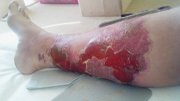By SANCHESKA BROWN
Tribune Staff Reporter
sbrown@tribunemedia.net
WITH health officials yet to admit knowledge of a Bahamian man being treated for a deadly flesh-eating bacteria, two Americans are now claiming to have contracted the salt water borne infection while vacationing in the Bahamas.
One tourist told The Tribune he stayed at a resort in the Bahamas last month and went diving at several locations around the island. As soon as he got home on September 29, the man – who only wanted to be identified as Mark A – said he noticed that his leg had started turning red.
“On September 30, dark red lesions started forming accompanied by a high fever and very bad headache. That was enough to make me go to the emergency room on the evening of the 30th. They diagnosed me with cellulitis of unknown cause and they admitted me and started intra-venous antibiotics.
“They first mentioned vibrio (vulnificus) as a possible cause about three days into my treatment. I was released from the hospital on October 12 on oral antibiotics,” Mark A said.
“I am not showing symptoms of ingestion, so the doctors think the bacteria got into my skin through some insect bites on my ankle. It has been localised to my lower right leg, but almost covers the entire area. I was the only one in my family of four (me, wife, daughter, mother-in-law) to get sick. We did all the same things and ate the same things for the most part.”
The only difference, he said, is that he went diving at several different locations around the island.
“I will add the caveat that although my doctors originally told me the cause of my cellulitis was vibrio vulnificus, they also told me there was no way to be 100 per cent sure of the cause,” he said, adding that doctors told him he was lucky to be alive as his infection was very aggressive.
He posted his experience on Travel Advisor, where he insisted he would return to the Bahamas again in a few years – if his wife lets him.
Meanwhile, according to a news report in Florida – where vibrio vulnificus has killed 10 people this year – Steve Gyland of West Palm Beach also contracted the bacteria while on a diving trip in the Bahamas.
“It was like you were on fire. Like a burn-blister from a fire. It was weeks before I could walk on that leg,” Mr Gyland is quoted as saying.
“You could just watch the red, blistery skin just grow and expand and move up your leg.”
The wptv.com report, by Jeff Skrzypek, did not say exactly when or where Mr Gyland believes he was infected.
Last week, the family of a Bahamian man fighting for his life in hospital claimed he contracted the bacteria while in coastal waters off Andros.
One relative described it as a “very, very serious situation” and said the victim is “very ill.”
Despite trying for almost two weeks to get a response on this case from Ministry of Health officials, e-mails and phone messages were not returned.
After the story appeared in The Tribune, Health Minister Perry Gomez acknowledged that he had heard “the rumour” of a Bahamian man having been infected, but has seen no evidence to prove it.
Dr Gomez added that he would be “very surprised” if the vibrio vulnificus is behind the man’s condition, as to his knowledge, the symptoms do not add up.
“The organism that I was told was said to be in Florida, was said to be a vibrio and to my knowledge the vibrio organisms are not flesh eating organisms, so (it) must be something else. The vibrio organism tends to cause diarrhoea diseases not diseases that are termed ‘flesh-eating’,” the minister said.
According to the Centres for Disease Control (CDC), in the United States, symptoms usually include vomiting, diarrhoea, and abdominal pain.
However, the CDC said in immuno-compromised persons, particularly those with chronic liver disease, it can infect the bloodstream and cause a severe and life-threatening illness characterised by fever and chills, decreased blood pressure (septic shock), and blistering skin lesions.
Bloodstream infections are fatal about 50 per cent of the time, the CDC said.
The bacteria can also cause an infection of the skin if open wounds are exposed to warm seawater – often leading to skin breakdown and ulceration.
It is this characteristic which has led to its characterisation as “flesh eating”.
Vibrio vulnificus bacteria is related to the microbes that cause cholera.
It normally lives in warm seawater and is part of a group of vibrios that are called “halophilic” because they require salt, the CDC said.
It can be contracted by eating contaminated seafood, by ingestion, or through an open wound that is exposed to seawater.






Comments
Use the comment form below to begin a discussion about this content.
Sign in to comment
Or login with:
OpenID